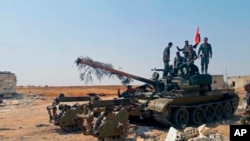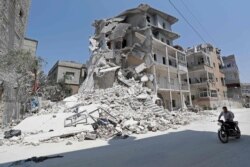The pace of Russian and Syrian government airstrikes and artillery shelling of the northern Syrian province of Idlib, the last stronghold of what remains of secular rebel and jihadist forces opposed to President Bashar al-Assad’s rule, has picked up, say independent monitoring groups.
After months of deadly bombardment, Syrian government forces were reported Wednesday to be inching closer toward the strategic town of Khan Shaykhun in the southern countryside of the province.
The town, which was the target of an alleged government sarin gas attack in April 2017, sits just 350 meters off the main highway linking Aleppo and Damascus.
If forces loyal to President Assad manage to capture the town — a prize that has eluded them since 2014 — then they will be able to complete an encirclement of the remaining pocket of rebel-held territory in neighboring Hama province to the south, say analysts.
Government forces are within four kilometers of Khan Shaykhun, according to Rami Abdulrahman, director of the Britain-based Syrian Observatory for Human Rights, a network of activists. The monitoring group also says open fields are all that separate government forces from the town. Reporters on the ground say remaining civilians in the town are fleeing north toward the border with Turkey.
Since the collapse this month of a cease-fire that lasted just days, government forces with the backing of Russian warplanes have managed to take several tactically important positions in the province, including the town of al-Habeet, on Saturday. A buffer zone deal struck by Russia and Turkey in 2018 was supposed to protect Idlib from an offensive, but it was never fully observed.
Earlier this year, former al-Qaida affiliate Hayat Tahrir al-Sham extended control of much of Idlib. The former affiliate has also been battling Islamic State factions in the province and last week said it had killed Abu Khalid Talmanas, the top Islamic State commander in Idlib. The province is home to more than 3 million Syrians, many of them displaced from elsewhere in the war-ravaged country.
The increased bombing coincided with Eid al-Adha, the Feast of the Sacrifice, the second of two Islamic holidays celebrated each year and considered the holiest. It honors the willingness of Ibrahim (Abraham) to sacrifice his son as an act of obedience to God's command.
“At a time set aside for holiness and celebration, Eid al-Adha is covered with the blood of Syrians, with the continued Russian and regime airstrikes and intensive shelling on the countryside of #Idlib and #Hama, causing significant civilian casualties,” tweeted the White Helmets, a volunteer rescue group, as the holiday ended Sunday.
In the past four months, Russian and Syrian warplanes have struck more than 40 health care facilities in Idlib. Since July 26, there have been more than 500 air attacks, which have left more than 800 civilians dead and hundreds of others injured, according to monitoring groups.
The attacks have been compared to a “scorched-earth policy” by U.N. officials, who are currently investigating charges that Syrian government and Russian forces have been deliberately targeting clinics.
Physicians for Human Rights, a U.S.-based advocacy group, has said that since the Syrian government and Russia launched their offensive on rebel-held areas in Idlib and northern Hama on April 29, 16 of the attacks have been fully verified. The location coordinates of the facilities had been shared with the warring parties by the United Nations under a deconfliction system aimed at ensuring they would not be attacked.
U.N. Secretary-General Antonio Guterres has ordered an inquiry into the attacks. The probe will investigate whether the GPS coordinates provided by the U.N. to Russia have been used to target the hospitals.
Mark Lowcock, U.N. undersecretary-general for humanitarian affairs and emergency relief coordinator, said recently: “I have asked the Russian Federation for clarification of what it does with the information.”
“The most dangerous place to be in Idlib is a hospital,” according to the British surgeon David Nott. “That is the chilling fact I was told by doctors when I was in northern Syria days ago teaching surgeons how to treat blast injuries and gunshot wounds,” he wrote in an article.
Last week, the British foreign secretary, Dominic Raab, tweeted, “Appalled by situation in Idlib and how Assad, backed by Russia, revoked a ‘conditional’ cease-fire just days after announcing it — a repeated pattern of behavior. Attacks on civilian targets are a violation of international humanitarian law — this must stop.”
His remark earned an immediate response from Syrian political activists demanding to know what the West planned to do about the assault.
A 15-kilometer demilitarized buffer zone was meant to have been established along the front lines separating the opposition and government forces under an agreement struck last September in a deal between the leaders of Russia and Turkey. The move shelved a threatened all-out assault on Syria's last rebel stronghold by the Russia-backed Assad government.
Under the terms of the deal, all "radical fighters" were meant to withdraw from the zone and all opposition factions would remove heavy weaponry. By the end of 2018, transportation routes between Syria's port of Latakia with Aleppo and Hama were meant to have been restored.
Rebel leaders say the military objective of the intensified airstrikes appears to be aimed at seizing control of highways M5 and M4. But they are warning also the air assault may herald the start of a final government offensive on the rebel enclave, much as intense bombing did in 2016 before a successful government assault on Aleppo.








